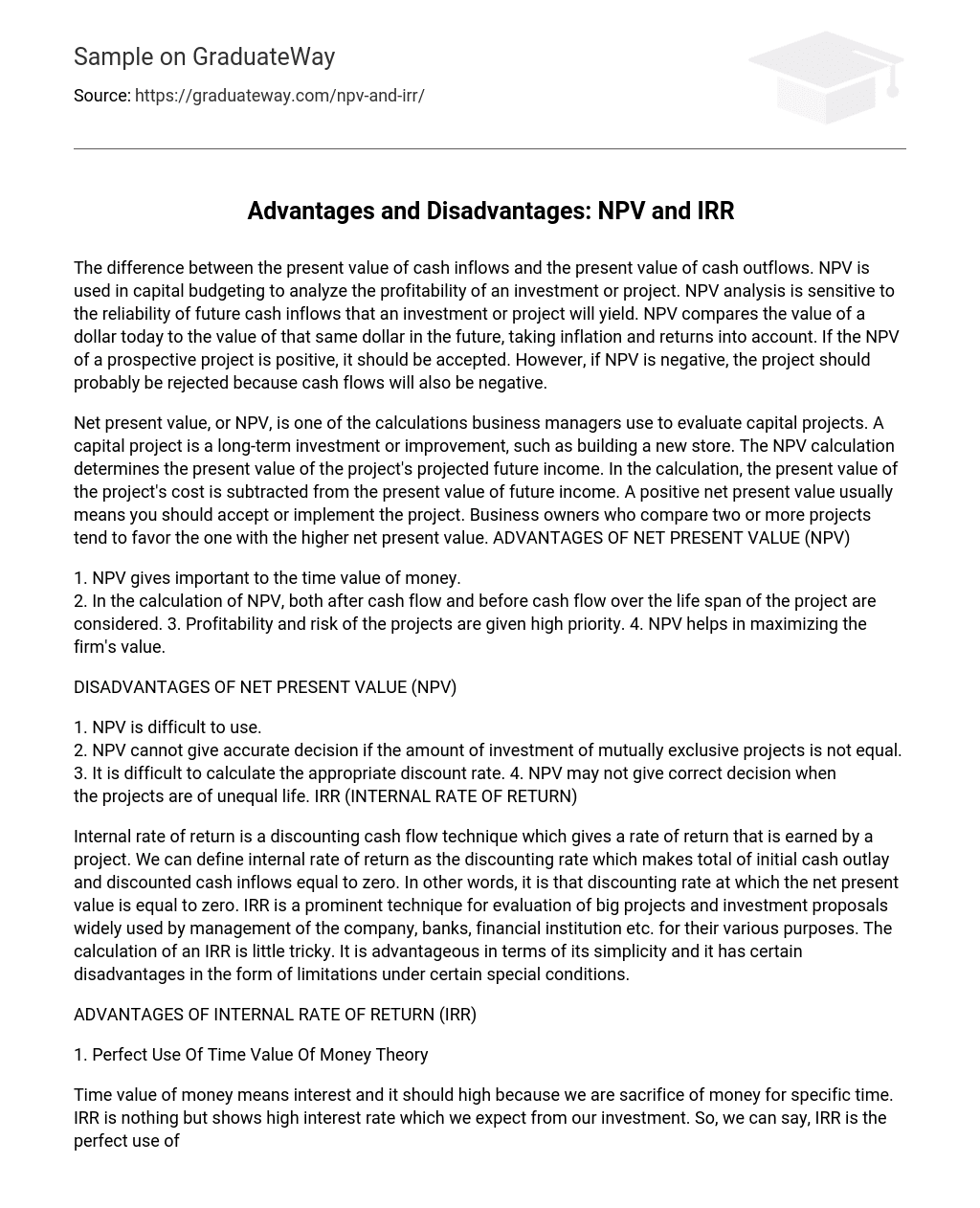The Net Present Value (NPV) or NPV is a widely used calculation that assesses the difference between current cash inflows and outflows. It plays a significant role in evaluating investment profitability in capital budgeting. The analysis of NPV involves comparing the present value of money with its future value, considering factors like inflation and returns, which determines the reliability of future cash inflow. If an investment or project has a positive NPV, it indicates potential and should be pursued; however, if it has a negative NPV, it is likely to be rejected due to negative cash flows.
Net present value (NPV) is a financial calculation that business managers use to assess capital projects, like building a new store. NPV gauges the current value of projected future income for a project by deducting the present value of costs from the future income. A positive NPV suggests that the project should be authorized or executed. When comparing projects, entrepreneurs typically favor those with greater net present values. There are numerous advantages to utilizing net present value.
The significance of the time value of money in NPV is emphasized as it takes into account cash flow before and after throughout the project’s lifespan. The focus is on assessing project profitability and risk to maximize firm value.
The drawbacks of Net Present Value (NPV) are as follows:
1. The use of NPV presents challenges.
2. NPV is not dependable for making precise decisions when the investment amounts of mutually exclusive projects are unequal.
3. Calculating the appropriate discount rate can be challenging.
4. NPV may yield inaccurate decisions when the projects have differing lifespans.
IRR (INTERNAL RATE OF RETURN)
The method of discounting cash flow known as internal rate of return (IRR) provides the rate of return earned by a project. IRR can be defined as the discount rate that makes the total of initial cash outlay and discounted cash inflows equal to zero. In simpler terms, it is the discount rate at which the net present value is zero. IRR is commonly used by companies, banks, and financial institutions to evaluate large projects and investment proposals. Despite its limitations under certain conditions, calculating IRR can be challenging but offers simplicity benefits.
Benefits of Internal Rate of Return (IRR)
Perfect utilization of the theory of the time value of money.
The concept of time value of money implies that there is an interest component associated with the sacrifice of money for a specific period. The internal rate of return (IRR) represents the expected high interest rate that we anticipate from our investment. Therefore, we can conclude that IRR effectively applies the theory of time value of money.
2. Every cash flow holds the same level of significance.
An effective method of capital budgeting is to assign equal importance to all cash flows, regardless of timing. This approach involves establishing a relationship with different rates and determining the point at which the present value of cash inflow matches the present value of cash outflow.
3. Uniform Ranking
There is no specific basis for choosing a particular rate when it comes to the internal rate of return.
The primary goal is to optimize profits for shareholders.
Choosing the project with an Internal Rate of Return (IRR) that is higher than the system’s cut-off rate will maximize profitability for the shareholders.
The Internal Rate of Return (IRR) may yield misleading outcomes in specific scenarios.
The concept of IRR can be difficult to comprehend.
Understanding the calculation of various rates can be challenging for many students. This challenge becomes even more intricate when dealing with the Internal Rate of Return (IRR), which involves two experimental rates resulting from a disparity between present values of cash inflow and outflow. Additionally, IRR is founded on unrealistic assumptions.
The IRR calculation assumes that any investment profits can be reinvested at the same rate. However, this assumption is unrealistic, so a hurdle rate is not required.
The hurdle rate, or cost of capital, is the required rate of return for investors to fund a project in capital budgeting analysis. It is an approximate estimate and often subjective. However, the IRR method does not rely on the hurdle rate, reducing the risk of determining an incorrect rate. Instead, it calculates the IRR to determine if it exceeds the estimated cost of capital. This enables the selection of projects with higher IRR than the estimated cost of capital. A comparison can be made between net present value (NPV) and internal rate of return (IRR).
Both the NPV and IRR methods have their own advantages and disadvantages, but they are both valuable tools for determining whether or not to move forward with a project.
Advantages:
The NPV method directly measures the dollar contribution to stockholders, while the IRR method demonstrates the return on the original investment.
Disadvantages:
Both the NPV method and the IRR method have drawbacks. The NPV method lacks a measure of project size, whereas the IRR method can occasionally yield conflicting answers when compared to NPV for mutually exclusive projects, resulting in what is known as the ‘multiple IRR problem.’ This issue will be further discussed. Now, we must ask why the NPV and IRR methods generate contradictory rankings.
When assessing an independent project, the determination to invest in the project is not affected by other projects. In such instances, both the NPV and IRR will consistently produce identical results, whether it is deciding to accept or reject the project.
Although NPV and IRR are useful metrics for assessing alternative projects, they may not always offer identical guidance due to variations in cash flow timing and project sizes.





